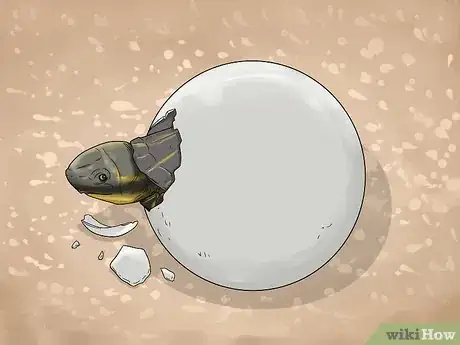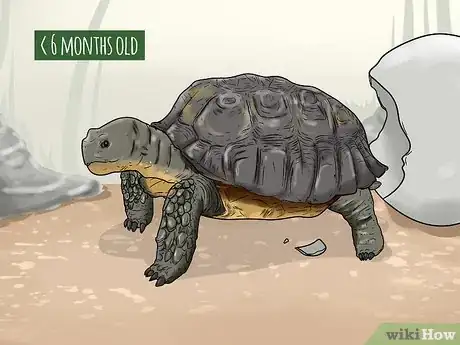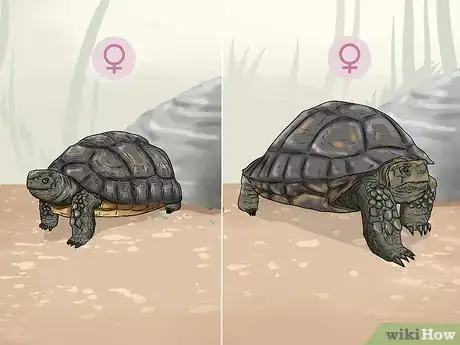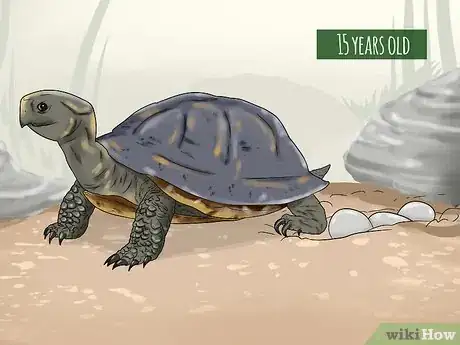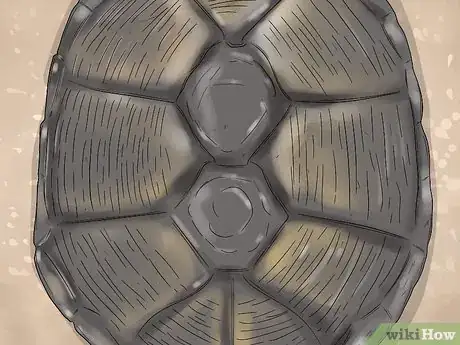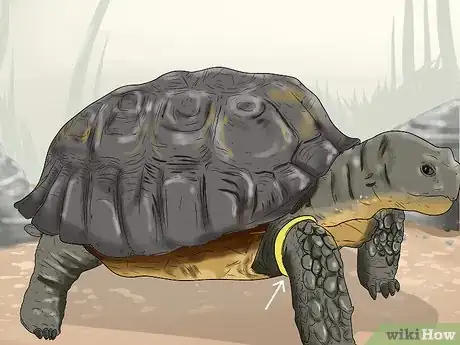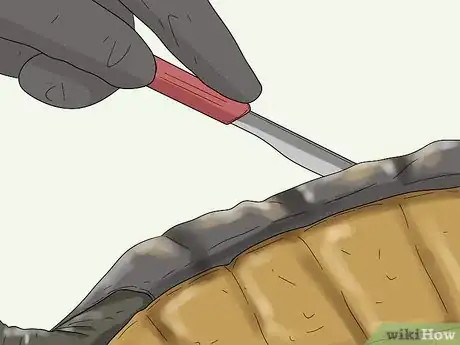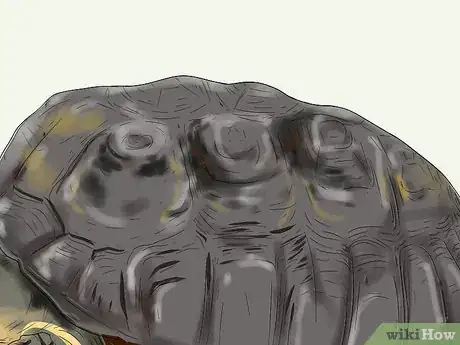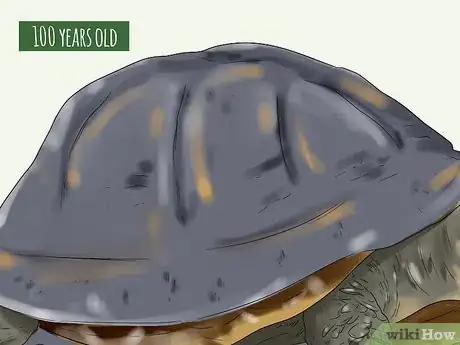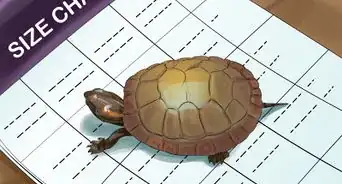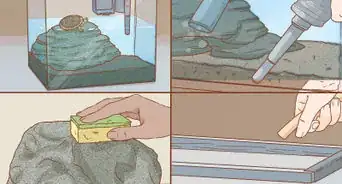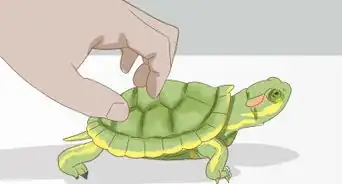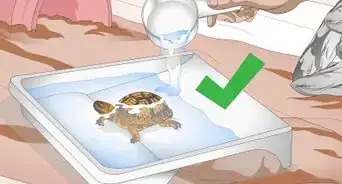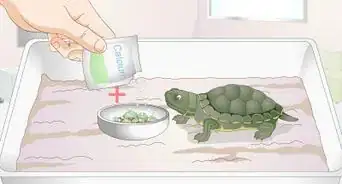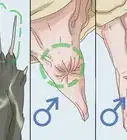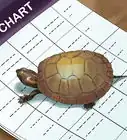This article was co-authored by wikiHow staff writer, Christopher M. Osborne, PhD. Christopher Osborne has been a wikiHow Content Creator since 2015. He is also a historian who holds a PhD from The University of Notre Dame and has taught at universities in and around Pittsburgh, PA. His scholarly publications and presentations focus on his research interests in early American history, but Chris also enjoys the challenges and rewards of writing wikiHow articles on a wide range of subjects.
There are 7 references cited in this article, which can be found at the bottom of the page.
This article has been viewed 83,526 times.
Learn more...
Tortoises can sometimes live for 100 years or more, but don’t expect your tortoise to be eager to reveal its age! Unless you know when a tortoise was born, it’s very difficult to make an accurate estimate with confidence, even for experts who study wild tortoises. By using visual inspection and perhaps some testing methods, though, you can make a fairly educated guess about the age of a captive or wild tortoise.
Steps
Approximating Your Tortoise’s Age
-
1Keep track of the tortoise’s “hatch date” for 100% certainty. There’s no way around it—the only way to be certain of a tortoise’s age is to know when it hatched! Beyond that, everything else is guesswork that relies on varying degrees of scientific rigor.[1]
- If you only need a rough estimate to answer questions about the tortoise’s diet, breeding capacity, or anticipated full-growth size or lifespan, then using general age-determination methods should be sufficient.
-
2Assume a baby tortoise with a soft shell is under 6 months old. Baby tortoises naturally have semi-rigid shells early in life, but they typically harden fully by 6-8 months of age. The softer the shell, the younger the tortoise is likely to be.[2]
- Don’t press on the shell to determine how soft it is! Just touch it gently, or you may injure the tortoise.
- A tortoise’s shell (more accurately called a carapace) is part of its bone structure. This means that a tortoise experiences pain if its carapace is damaged.
Advertisement -
3Compare its size to the average same-sex adult of its species. Tortoises have a somewhat similar average lifespan to humans, meaning they also tend to reach their maximum size (in length, not necessarily weight) at around 15-20 years of age. Check online for the average adult male or female length for your species, then measure your tortoise for comparison.[3]
- Tortoises are measured by straight-line carapace (shell) length. Hold a tape measure level above your tortoise’s shell—don’t follow the curve of the shell—and “eyeball” the length in either inches or centimeters.
- For example, female desert tortoises (native to the southwestern U.S.) grow to an average length of 7–8 in (18–20 cm).
- Keep in mind that the growth of a tortoise depends on the temperature it is kept at and the food that it gets. An animal that has optimal conditions might be full-grown in five years, whereas an animal that didn’t get enough heat or food might still be very, very small when it is five years old.
-
4Use sexual maturity as a sign a tortoise is at least 15. As with reaching adult size, tortoises tend to be like humans in reaching sexual maturity during their late teens. So, if your female tortoise lays eggs, you can assume that it—and at least one male it’s in contact with—is at least 15 years old.[4]
- Different species of tortoise lay differing numbers of eggs, generally ranging from 1-30 at at time. The most common range is from 6-10.
-
5Count scute rings on the shell for a very rough age estimate. A tortoise’s shell looks a bit like a quilt, with oblong-shaped “patches” (known as scutes) that individually grow larger as the shell increases in size. This process of expansion creates visible growth rings inside each scute, and some tortoise-lovers believe that counting these rings is a good way to estimate the animal’s age.[5]
- Count each thicker ring (which develops during the tortoise’s main annual growth period) and the thinner ring beside it (which develops during the annual slow growth period) as a single ring. So, if you count 20 of these ring pairs, you might estimate the tortoise is 20 years old.
- Many experts view this as a very unreliable (or even useless) method for determining age, since rings develop during growth spurts, which don’t necessarily happen annually. A tortoise with 30 rings could easily be 20 or 40 years old (if not even 10 or 50), for instance.[6]
-
6Ask your vet to do some tests and offer their best guess. Your veterinarian may be able to take a blood sample and send it to a lab for testing to gain further insights into your tortoise’s age. For the most part, though, they’ll use the same observational techniques you can use at home—but they almost certainly have more experience in estimating the age of animals![7]
- A blood sample can provide a metabolic profile that can help in making an age estimate, but it’s by no means a foolproof way to establish an animal’s age. Blood samples can be very helpful in identifying illnesses in tortoises and other animals, though.
Estimating a Wild Tortoise’s Age
-
1Follow a “mark and recapture” protocol over years or decades. This is the gold standard for tracking the age of a wild tortoise, but it takes a lot of time and effort. Tortoises are identified and tagged when young—ideally age 2 or younger—and re-tagged at regular intervals over the ensuing years to track their age, health, and other factors.[8]
- Electronic tagging removes some of the leg-work from the “mark and recapture” process, but it still requires a long-term commitment to track individual tortoises for decades.
-
2Dissect a dead tortoise for skeletochronology testing. While counting the “growth rings” on a tortoise’s shell is a questionable way to estimate its age, counting and measuring the growth layers on its bones is fairly effective. Unfortunately, this type of testing can only be done once the tortoise is deceased![9]
- Skeletochronology testing typically involves cutting cross-sections of the scapula, humerus, femur, and ilium for examination.
-
3Conduct laboratory blood tests for age markers. Some “mark and recapture” programs include doing blood draws at regular intervals for testing. A tortoise’s metabolic profile offers some insights into its age range, but it won’t provide a specific age estimate. Blood tests are best used in conjunction with other age estimation tools.[10]
- As with captive tortoises, blood testing is more useful in identifying illnesses in wild tortoises.
-
4Test the fungi growing on the tortoise’s shell. A wild tortoise’s carapace naturally becomes a fungus host over the years and decades of its long life. By evaluating the extent of fungal growth on a shell and taking samples to test for composition and other factors, experts can hazard a general estimate of the host tortoise’s age.[11]
- In basic terms, more fungus equals an older tortoise. It’s a bit more complicated than that for the scientists doing the testing, though!
-
5Look for a smoothed-out shell in a centenarian tortoise. Tortoises can live long enough for their shells to experience erosion from rainfall and blowing sand. Over time, the bumps, rings, and ridges of the scutes can become smoothed out. Generally speaking, a wild tortoise with a very smooth shell is probably around 100 years old or older.[12]
- This method can only give a very broad estimate. Some tortoises naturally have smoother shells than others, and environmental conditions factor heavily into erosion rates.
-
6Formulate a “best guess” based on additional visual inspection. Generally speaking, the older a tortoise gets, the slower it moves, the less it eats, and the more wear-and-tear becomes visible on its body. Experts who spend lots of time around tortoises can use these visual factors to give educated guesses on age. They might be able to estimate within a range of 3-5 years for a juvenile tortoise and perhaps 10 years for a mature one.[13]
- Unless a wild tortoise has been tracked from near birth or has died and undergone skeletochronology, even tortoise experts are left having to make a “best guess” about its age.
References
- ↑ https://www.int-res.com/articles/esr2008/5/n005p021.pdf
- ↑ http://www.reptilesmagazine.com/Reptile-Health/Disease-Management/Three-Common-Ailments-Of-Tortoises-In-Captivity/
- ↑ http://tortoisegroup.org/wp-content/uploads/PDFs/sheet2-sexing-copy.pdf
- ↑ https://www.petmd.com/reptile/care/how-tell-turtles-age
- ↑ http://www.reptilesmagazine.com/Turtles-Tortoises/Turtle-Care/Reptile-Shell-Markings/
- ↑ https://www.int-res.com/articles/esr2008/5/n005p021.pdf
- ↑ https://www.petmd.com/reptile/care/how-tell-turtles-age
- ↑ https://www.int-res.com/articles/esr2008/5/n005p021.pdf
- ↑ https://www.int-res.com/articles/esr2008/5/n005p021.pdf
